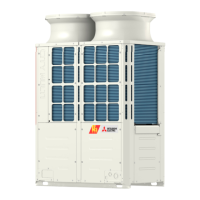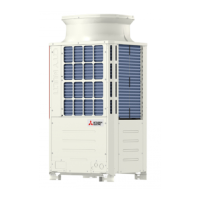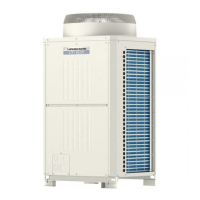How to fix abnormal bus voltage rise in Mitsubishi Electric PURY-P72?
- PpamelariveraSep 7, 2025
If your Mitsubishi Electric Air Conditioner is experiencing an abnormal bus voltage rise, monitor and control the voltage output.

How to fix abnormal bus voltage rise in Mitsubishi Electric PURY-P72?
If your Mitsubishi Electric Air Conditioner is experiencing an abnormal bus voltage rise, monitor and control the voltage output.
What to do if Mitsubishi Electric Air Conditioner has overload protection?
If your Mitsubishi Electric Air Conditioner is experiencing overload protection issues, assess the load conditions and reduce the load if necessary.
How to fix heatsink overheat protection in Mitsubishi Electric PURY-P72?
If your Mitsubishi Electric Air Conditioner is experiencing heatsink overheat protection, check the cooling systems and make sure there is adequate airflow.
How to fix RPM error/motor error in Mitsubishi Electric PURY-P72 Air Conditioner?
If you are getting an RPM error or motor error on your Mitsubishi Electric Air Conditioner, check the motor operation. Replace the motor if it is faulty.
How to fix temperature sensor fault in Mitsubishi Electric PURY-P72 Air Conditioner?
If there is a temperature sensor fault in your Mitsubishi Electric Air Conditioner, replace the faulty temperature sensors.
How to fix communication error between device and transmission processors in Mitsubishi Electric Air Conditioner?
To resolve a communication error between the device and transmission processors in your Mitsubishi Electric Air Conditioner, check the wiring connections and replace any damaged cables.
What to do if Mitsubishi Electric PURY-P72 Air Conditioner has water supply cutoff?
If the water supply is cutoff to your Mitsubishi Electric Air Conditioner, verify that the water supply is active and the connections are secure.
How to fix transmission power supply fault in Mitsubishi Electric PURY-P72?
If there is a transmission power supply fault in your Mitsubishi Electric Air Conditioner, inspect the power supply connections.
What to do if Mitsubishi Electric PURY-P72 has discharge temperature fault?
If your Mitsubishi Electric Air Conditioner is showing a discharge temperature fault, inspect the discharge temperature sensor for failure.
How to fix serial communication error in Mitsubishi Electric Air Conditioner?
To resolve a serial communication error in your Mitsubishi Electric Air Conditioner, check the wiring connections and replace any damaged cables.
| Brand | Mitsubishi Electric |
|---|---|
| Model | PURY-P72 |
| Category | Air Conditioner |
| Language | English |
Defines WARNING and CAUTION symbols and provides general safety advice.
Covers requirements for qualified installers, proper mounting, and electrical safety measures.
Addresses refrigerant leaks, ventilation, and installation in specific environments.
Highlights safety for terminal block covers, refrigerant types, and control box access.
Details specific hazards and precautions for handling R410A refrigerant.
Specifies requirements for refrigerant piping material and proper storage methods.
Outlines procedures for refrigerant charging and tool compatibility for R410A.
Provides warnings about gas leaks, ignition hazards, and unusual installation environments.
Specifies non-standard uses and environmental conditions to avoid during installation.
Covers proper grounding, wire selection, tension, and breaker requirements.
Addresses precautions related to water exposure, product transport, and packing material disposal.
Covers CAUTION symbols and general safety during test run preparation.
Details requirements for unit power-on duration and power interruption.
Provides warnings about touching hot/cold parts, operating without panels, and air filters.
Lists essential tools and materials required for installation and servicing.
Details copper pipe materials, types, radial thickness, and processing.
Covers brazing procedures, solder types, and air tightness test methods.
Explains vacuum drying procedures and refrigerant charging methods.
Compares refrigerants and provides notes on refrigerating machine oil.
Summarizes compatible indoor unit types for different outdoor units.
Details cable types, number of cores, cable size, and maximum transmission distances.
Explains switch settings for units and address assignment for system components.
Provides examples of typical system connections for remote controllers.
Details pipe sizes for BC controller connections to outdoor and indoor units.
Outlines allowable lengths for various pipe sections in different system configurations.
Illustrates the front view of various outdoor unit models.
Provides schematic diagrams of the refrigerant circuit for different outdoor units.
Shows the internal layout of control boxes and circuit boards.
Compares the functions and specifications of MA and ME remote controllers.
Provides criteria for choosing between MA and ME remote controllers for system requirements.
Details group settings and interlock configurations via ME and MA remote controllers.
Presents the electrical wiring diagram for the outdoor unit.
Illustrates the electrical wiring diagram for the BC controller.
Provides the electrical wiring diagram for the transmission booster.
Shows schematic diagrams of the refrigerant circuits for various models.
Details the main parts of the refrigerant circuit and their functions.
Explains the functions and default settings of the unit's dipswitches.
Describes the control methods for the outdoor unit, including startup sequences.
Details the control logic for solenoid valves and LEV within the BC controller.
Illustrates the flowcharts for indoor unit, outdoor unit, and BC controller operation modes.
Lists essential checks and preparations before conducting a test run.
Provides step-by-step instructions for performing a test run using the MA remote controller.
Explains how to adjust refrigerant amount based on operating characteristics and symptoms.
Describes symptoms that are considered normal during unit operation.
Provides reference data for standard operation conditions across various models.
Lists all error codes and their definitions for troubleshooting.
Details how to respond to error displays shown on the remote controller.
Covers issues related to M-NET transmission, wave shape, and noise interference.
Provides troubleshooting steps for principal parts like sensors and valves.
Addresses refrigerant leaks, compressor replacement, and related troubleshooting.
Details procedures for servicing the BC controller and its components.
Explains how to interpret LED error displays on the outdoor unit board.
Explains how to interpret numerical and flag displays on the service monitor.
Details information displayed on the monitor screen during initial settings.
Describes the unit's clock function and storage of error history data.











